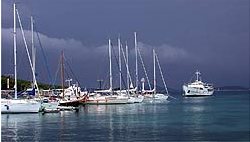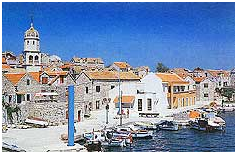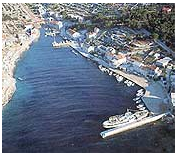The archipelago consists of 249 islands, islets and reefs, which forms an area of 157 square kilometers. Six of them are permanently inhabited (by around 6600 people).
Zlarin

The island of corals with a single village also named Zlarin. The first written document mentioning the island dates from 1386. The gothic Our Lady of Rašelj church (XV ct.) stands out in the island’s architecture with its numerous paintings. Other very interesting sites are the baroque church of Our Lady of Assumption, St. Roko (St. Rocco) and St. Šimun (St. Simon) chapels from the XVII ct. The islanders have been known for their fishing, sailing and coral processing (unique in the Adriatic ) skills. Coral jewellery is still manually crafted in a small island factory. The original female garb/ costume is a part of its rich cultural and social heritage.
Otok Prvić

This island was inhabited in the early medieval times. In the XVI century, the people from the nearby mainland formed a settlement named Luka, in an islands bay. The following century saw the birth of another settlement, named Šepurine. The latter is known for its Our Lady of Assumption church, the baroque St. Rocco church (XVII ct.) and Our Lady of the Holy Visit (dating from XV ct., restaurated in 1878). There is a column with a capital on the coast, allegedly brought there from the Roman settlement Salona. A congregation of Glagolitic friars also inhabited Prvić Luka. It was the strongest point of Slavic liturgy in the Šibenik area. Aristocrat families from Šibenik owned most of the island’s land, among others the Vrančić and Draganić families. Faust Vrančić, a renowned scientist, writer, philosopher, mathematician and physicist was buried in the Luka parish church.
Žirje

It is the furthest point in the Šibenik archipelago. Remnants of fortifications from the late Roman period can be found above the Mala and Velika Stupica ports. In 1059, Croatian king Petar Krešimir IV gave the island to Benedictine monks. Numerous Šibenik families owned land on the island during Venetian occupation. In the recent Homeland War it had a vital role in the defense of the city, a fact that confirms the island’s strategic importance throughout its long history.
Kaprije
It got its name after “kapar” (caper) a Mediterranean plant used as a spice. Its beauty and protected port attract many nautical tourists and yachts. The island’s St. Peter church was built on the turn of the XV century. The inhabitants, once great sailors and fishermen, have recently started turning to tourism as an additional source of income.
Kakan
Dubbed the “island of the children of the world”, this uninhabited island was relinquished by the City Assembly of Šibenik for the “Seventh Continent – children of the world’ town” project in 1970. The idea was to bring children from all over the world to stay there for a while, to spend time together and create their own world in the unspoilt nature. The project was sponsored by the U.N. but was temporarily cancelled due to war.
Obonjan – otok mladosti
Its thick pinewood forest and secluded beaches make it a perfect destination for swimming and fun-desiring youth from all over the world. Premises were built on the island with the facilities necessary for organized activities and comfortable stay of all young visitors.
